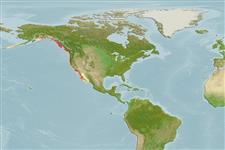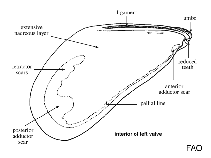Mytilus californianus Conrad, 1837
California mussel| Native range | All suitable habitat | Point map | Year 2050 |

|
| This map was computer-generated and has not yet been reviewed. |
| Mytilus californianus AquaMaps Data sources: GBIF OBIS |
Google image | No image available for this species;
drawing shows typical species in Mytilidae.
Classification / Names Tên thường gặp | Các synonym ( Các tên trùng) | CoL | ITIS | WoRMS
Bivalvia | Mytilida | Mytilidae
Environment: milieu / climate zone / Mức độ sâu / distribution range Sinh thái học
; Mức độ sâu 0 - 100 m (Tài liệu tham khảo 95344), usually 0 - 30 m (Tài liệu tham khảo 104320). Temperate; 62°N - 18°N, 180°W - 109°W
Distribution Các nước | Các khu vực của FAO | Các hệ sinh thái | Những lần xuất hiện | Những chỉ dẫn
Eastern Pacific: from Aleutian Islands, Alaska, USA to Baja California and Isla Socorro, Mexico. Subtropical to boreal.
Length at first maturity / Bộ gần gũi / Weight / Age
Chín muồi sinh dục: Lm ? range ? - ? cm Max length : 25.5 cm TL con đực/không giới tính; (Tài liệu tham khảo 95344); common length : 20.0 cm TL con đực/không giới tính; (Tài liệu tham khảo 312)
Short description Hình thái học
Life cycle and mating behavior Chín muồi sinh dục | Sự tái sinh sản | Đẻ trứng | Eggs | Sự sinh sản | Larvae
Main reference
Các tài liệu tham khảo | Người điều phối | Người cộng tác
Gallivan, G. and J. Danforth 1999 Phylum Mollusca. Marine Science Institute. Http://216.239.51.104/search?q=cache:EEiLeA0OeAMJ:www2.ucsc.edu/simp/guide.pdf+Nuttalina+californica&hl=tl&gl=ph&ct=clnk&cd=8 [accessed 20/01/06] (Tài liệu tham khảo 312)
IUCN Red List Status
(Tài liệu tham khảo 130435: Version 2025-1)
CITES status (Tài liệu tham khảo 108899)
CMS (Tài liệu tham khảo 116361)
Threat to humans
Human uses
Các nghề cá: Tính thương mại
| FishSource | Biển chung quanh ta
Các công cụ
Thêm thông tin
Max. ages / sizes
Length-weight rel.
Length-length rel.
Length-frequencies
Mass conversion
Sự phong phú
Các nguồn internet
BHL | BOLD Systems | CISTI | DiscoverLife | FAO(Publication : search) | Fishipedia | GenBank (genome, nucleotide) | GloBI | Gomexsi | Google Books | Google Scholar | Google | PubMed | Cây Đời sống | Wikipedia (Go, tìm) | Tạp chí Zoological Record



